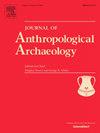大地与水之歌:埋葬洞穴神圣而生动的南方Jê巴西死亡景观
IF 2.2
1区 社会学
Q1 ANTHROPOLOGY
引用次数: 0
摘要
在这篇文章中,我们研究了巴西南部高地南部Jê埋葬洞穴(sjbc)的现有数据,讨论了它们的空间性、年代、象征方面,以及与另一种南部Jê埋葬习俗——土堆和围墙复合体(MECs)的关系。通过地图创建和时间分析,我们探索了以前用于解释这些丧葬习俗之间动态关系的时间顺序和等级假设。我们的研究结果表明sjbc比mec更古老。此外,公元1000年左右,与mec的出现相一致,Araucaria森林的扩张和种族间接触的加强影响了sjbc的变化,例如壁炉和陶器的结合。对开冈人和Laklãnõ人(现代南方Jê人)的民族志分析表明,墓葬洞穴是死亡景观的组成部分,代表着宇宙起源的神话,是人类和非人类的互动点,是生者和死者世界的边界。最后,对Perau das cabeas埋葬洞穴的可见性分析表明,mec和sjbc代表了管理临界阶段危险的相反策略:mec位于突出的景观位置,而Perau das cabeas仍然隐藏在周围的坑屋村中。本文章由计算机程序翻译,如有差异,请以英文原文为准。
A song of earth and water: Burial caves as sacred and animated Southern Jê deathscapes in Brazil
In this article, we examine existing data on Southern Jê burial caves (SJBCs) in the Southern Brazilian Highlands to discuss their spatiality, chronology, symbolic aspects, and relation to mound and enclosure complexes (MECs), another Southern Jê burial practice. Through map creation and temporal analysis, we explore chronological and hierarchical hypotheses previously used to explain the dynamic relationship between these funerary practices. Our findings suggest that SJBCs are older than MECs. Additionally, around 1000 CE—coinciding with the emergence of MECs—the expansion of the Araucaria forest and the intensification of interethnic contacts influenced changes in SJBCs, such as the incorporation of hearths and pottery. Ethnographic analysis of the Kaingang and Laklãnõ peoples (modern Southern Jê) indicates that burial caves were integral parts of deathscapes, representing cosmogonic myths, serving as interaction points between humans and non-humans, and boundaries between the worlds of the living and the dead. Finally, visibility analysis of the Perau das Cabeças burial cave suggests that MECs and SJBCs represent opposing strategies for managing the dangers of the liminal phase: MECs are situated in prominent landscape positions, while Perau das Cabeças remains hidden from surrounding pit house villages.
求助全文
通过发布文献求助,成功后即可免费获取论文全文。
去求助
来源期刊

Journal of Anthropological Archaeology
Multiple-
CiteScore
4.00
自引率
11.10%
发文量
64
期刊介绍:
An innovative, international publication, the Journal of Anthropological Archaeology is devoted to the development of theory and, in a broad sense, methodology for the systematic and rigorous understanding of the organization, operation, and evolution of human societies. The discipline served by the journal is characterized by its goals and approach, not by geographical or temporal bounds. The data utilized or treated range from the earliest archaeological evidence for the emergence of human culture to historically documented societies and the contemporary observations of the ethnographer, ethnoarchaeologist, sociologist, or geographer. These subjects appear in the journal as examples of cultural organization, operation, and evolution, not as specific historical phenomena.
 求助内容:
求助内容: 应助结果提醒方式:
应助结果提醒方式:


